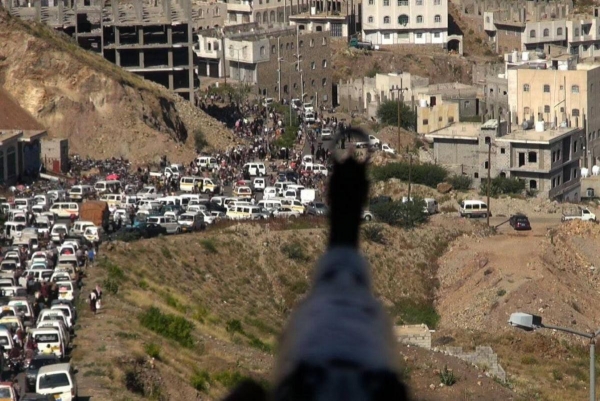The Longest Siege: The siege of Taiz exceeds the one thousand and one hundred days of continuous killing
Taiz:
The Longest Siege: The Human Rights Information and Training Center (hritc) was released today in Taiz
A report on the continuation of the siege of the city of Taiz by the Houthi coup militia under the title (*Taiz, one thousand and one hundred days of siege and continuous killing*)
The center, a non-governmental organization with consultative status at the United Nations, said that the siege of Taiz by the Houthis is among the longest types of siege that cities have been subjected to worldwide.
It could become the largest in terms of the continued systematic suffocation and killing of civilians.
The center stated that since the tightening of the siege in the invasion of Taiz on March 21, 2015 by the Houthi Militia and their Ali Saleh at the time, Taiz suffers from the continuation of the suffocating siege that prevents the movement of citizens and all kinds of food, medicine and life necessities.
In its report, the Center stated that the killing of civilians due to the deterioration of living conditions in Taiz is more tragic than the continued systematic shelling of residential neighborhoods.
Siege and war begin
—————————-
Houthi forces, backed by the army loyal to Ali Abdullah Saleh, who was allied with it at the time, invaded Taiz, the third largest city in Yemen, on March 22. There was no armed resistance, but rather peaceful protests and civil calls to prevent killing, despite the Houthis shooting demonstrators to disperse the protests. As a result, a demonstrator was killed and five others were wounded. Civilians did not take up arms at the time.
During a demonstration against the presence of the Houthis in Taiz on March 24, five demonstrators were killed by the Houthis and 80 others were injured, while in the city of Turbah (80 km southwest of Taiz), three demonstrators were killed and 12 others were injured.
After a week of fighting, the Houthis took control of the Mokha district in the governorate.
* A deadly siege to target civilians * The longest siege
—————————-
The city of Taiz witnesses the largest number of civilian casualties, as a result of the deliberate bombing by the Houthis and their followers
and various operations of targeting them. These forces tightened a deadly siege, preventing food, medicine, and the movement of citizens, confiscating all kinds of relief, and arresting unarmed citizens.
The siege of Taiz escalated in early October 2015, as forces loyal to the Houthis and Saleh, who were with them at the checkpoints, confiscated water, food, and cooking gas pipes from civilians trying to transport these supplies to neighborhoods within the city of Taiz that they do not control. The Houthis confiscated 3 medical drug trucks sent by the World Health Organization to Taiz in October 2015.
The Houthis also seized medicines destined for hospitals in areas not under their control and did not authorize the Ministry of Health offices to support hospitals and medical clinics in the city.
The report of the Information and Training Center for Human Rights alerted that on October 22, 2015, the International Committee of the Red Cross (ICRC) stated that about half of Taiz’s hospitals had stopped working due to a lack of supplies or fuel, or due to damage to facilities during the fighting.
It demanded that the controlling parties authorize the delivery of urgent and necessary medicines, which were banned for 5 weeks, to Al-Thawra Hospital.
On October 24, Doctors Without Borders said that despite weeks of intense negotiations with Houthi officials, a stock of essential medical supplies could not be delivered to two hospitals in Taiz, and that MSF trucks were stopped at Houthi security checkpoints and denied entry to the area.
On January 31, 2016, Human Rights Watch published a report entitled “Houthis Prevent Vital Goods Entry into Taiz”, in which it said that the Houthi forces, which imposed a siege on the city, restricted the entry of food and medical supplies to civilians in Taiz for months, and described the confiscation of basic goods for the civilian population and the prevention of Humanitarian aid as gross violations of international humanitarian law.
The United Nations estimated that two-thirds of the population of Taiz has been displaced due to the intensification of the siege.
The longest siege * The longest siege in history *
—————————-
The center said in its report
The siege of Taiz by the Houthis will enter the encyclopedia of records among the longest types of siege that cities were subjected to in various wars, after the siege of Sarajevo and the siege of Gaza, and prior to the siege of Leningrad in World War II, as Taiz completes its third year in a row while it is in a bloody siege.
By the beginning of May 2018, the siege of Taiz has exceeded 1,135 days, making it one of the longest types of siege in history, leaving behind and still the most human tragedy known to mankind.
What exacerbates the suffering is the world’s failure to heed this tragedy as it should, and what is supposed to be a moral and legal responsibility.
Where the world is still watching the worst types of systematic mass killing against Taiz and the most severe types of abuse and killing without moving a finger.
Massive siege and continuous calamity
—————————-
In its report, the Center explained the suffering of documentation and information gathering
An accurate count now of what happened and is happening to Taiz is not easy, because the siege is still continuing, the systematic killing is continuing, the confiscation of freedoms, the spread of killing and chaos is ongoing, which makes counting the accurate report very difficult.
However, the Human Rights Information and Training Center (hritc) worked through a working group and through various international reports, field news sources, and various working teams, including media teams and humanitarian missions.
In a synthesis report on the tragedy of the siege of Taiz.
The siege exceeded the barrier of 1,100 days of siege and continuous killing, something the world has not seen before except in a few incidents such as Sarajevo, Leningrad and Gaza, all of which are models preserved in the memory of history in a bloody way, and an unforgettable pain for the forces of terrorism, Nazism and extremism, so that the siege of Taiz comes, adding a more cruel and painful model. Houthi militia, whose siege continues until now.
It is the most prominent crime of these militias in the record of war crimes and the full-fledged crime in violating human rights and international humanitarian law.
The report is summarized
*Statistics of 3 years of war and siege in Taiz*:
According to an audited approach by the monitoring and documentation team at the Human Rights Information and Training Center for the full three years of the siege of Taiz, the violations in Taiz during the period from March 21, 2015 to March 31, 2018
As follows: The longest siege
The death toll reached: 3021 civilians, including 680 children and 371 women.
The number of injured reached 15,956 civilians, including 1,655 children and 2,449 women.
Tens of thousands of mines planted by the Houthi militia killed 714 civilians, including 32 children and 14 women, and 1,132 civilians, including 38 children and 17 women, were injured.
The number of raids by the Arab coalition reached 152, killing 576 civilians, including 107 children and 83 women, and wounding 398 civilians, including 56 children and 42 women.
Taiz suffered from cases of confiscation of freedoms, which amounted to 197 cases of abduction, 167 cases of enforced disappearance, 792 cases of arbitrary detention, and 87 cases of torture, many of which led to death or permanent disability, complete paralysis of movement, or insanity and psychological state.
About 2,861 families were displaced.
The total public property that was affected by the violation amounted to 452 properties, 9 buildings were blown up, 83 buildings and facilities were destroyed, 50 facilities and buildings were completely damaged, and 288 others were partially damaged, and 22 public vehicles were damaged.
While the total private property that was affected by the violation amounted to 1868 properties, 95 houses were blown up, 159 houses and private facilities were destroyed, 111 facilities and houses were completely damaged, and 1379 others were partially damaged, and 124 public vehicles were damaged.
https://hritc.co/21272?lang=en








